Introduction
In terms of audio quality, the PS200s weren't great. They had a subpar performance on our frequency response graph, had a bit more distortion than we typically see, and had an average isolation performance for a set of in-ears. They did, on the other hand, have good tracking, great leakage control, and were capable of a very high decibel output without much distortion.
We didn't find the PS200s to be particularly comfortable unless you weren't moving around much. The headphones tend to pop out of place with a relatively light tug or pull, making them less than ideal for exercise.
Product Overview
{{section_header}}{{section.name}}{{/section_header}}
The Phiaton PS200s are a basic set of in-ears.
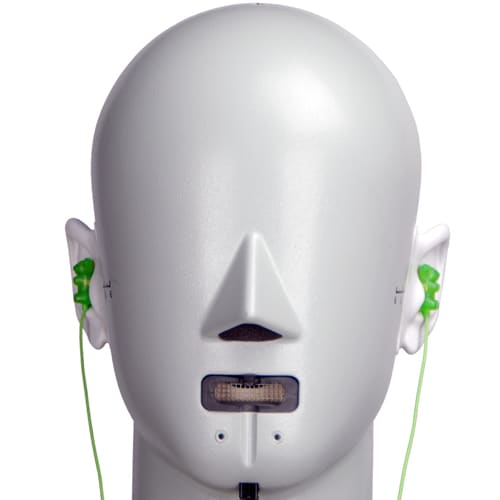
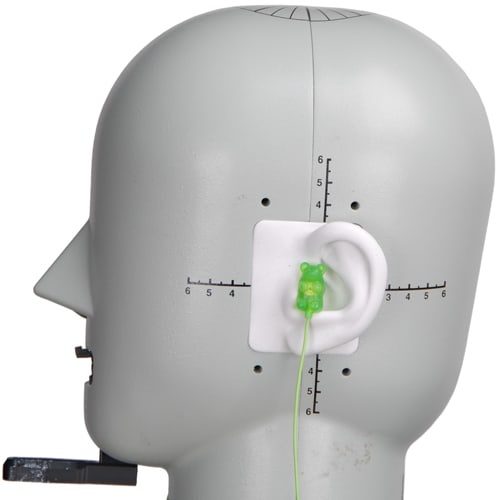
Speakers
{{section_header}}{{section.name}}{{/section_header}}
Since they don't do anything vastly different with the cord and plug, let's start by looking at their ear buds.
Sides
{{section_header}}{{section.name}}{{/section_header}}
As you can see, other than the gumdrop shape to the ear bud, these headphones look about average. The nozzles are a bit open, which will be a pain to clean if something gets in there.
Back
{{section_header}}{{section.name}}{{/section_header}}
Below you can see the PS200s' main design flourish, the fan blade.
Band
{{section_header}}{{section.name}}{{/section_header}}
Cable
{{section_header}}{{section.name}}{{/section_header}}
The PS200s are symmetrical headphones, meaning that the left and right cables are of an even length. If you held up the headphones, they'd look like an upper-case Y. By contrast, asymmetrical headphones typically have a much shorter cord leading up to the left ear bud and a longer one leading to the right ear bud, so they hang off to the left side and sling around the neck to the right.
The left and right sides converge at a neck split with an adjustable slider.
After the split, the cord continues down to a standard 1/8-inch plug.
Additional Features
{{section_header}}{{section.name}}{{/section_header}}
In the Box
{{section_header}}{{section.name}}{{/section_header}}
Inside the PS200s fancy-looking box you'll find the headphones, a posh carrying case, and two different sizes of sleeves (making 3 sizes total).
Durability
{{section_header}}{{section.name}}{{/section_header}}
The Phiaton PS200 headphones have the same durability issue as a lot of headphones we've reviewed: a fragile plug. These headphones are about on par with the Apple In-ear Headphones with Remote and Mic in terms of their horrible plug design. When you pick up headphones, try to get a plug that's bent at a 90º angle with a good cord guard. The plug is one of the biggest stress points on your headphones. If your headphones, much like the average videogame villain, fail to adequately protect their weak spot, we recommend wrapping the area in electrical tape as a precautionary measure. Sure, it will likely cheapen the overall aesthetic, but it will increase the longevity of your headphones.
Other than the plug issue, which is one of the most common problems we see on in-ear headphones, the only other real issue we saw was with the PS200s' nozzles. If you look at the below picture, you'll notice there're open to the air for the most part. This is bad, because it makes them far more vulnerable to accruing grossness and grime and is also annoyingly difficult to clean out.
Overall, the PS200s seem slightly less durable than average. They suffer from many of the common poor design choices in headphones, but aren't remarkable in their mediocre durability.
Aesthetics
{{section_header}}{{section.name}}{{/section_header}}
The PS200s have a fan blade design that's reminiscent of jet engines. We just reviewed the Turbines a while back, which seem to have followed this theme suspiciously closely. Overall, however, we weren't really 'fans' (this is the best pun ever) of the PS200s aesthetic. They have a unique look, which is refreshing, but the design on the back almost look like a bike wheel, as sometimes the shadowing makes the ridges there look like spokes. This being said, we're so used to boring designs that our inner, subjective, in-ear aesthetics scale only spans from, 'I don't really like the way this looks,' to 'I guess this looks kinda cool.' Our vague sense of dislike at the PS200s' design is made much less palpable by the sheer presence of an innovation.
Of course, aesthetics is entirely subjective. As we advise in every review, take all opinions (especially those found on the internet) with the grain of salt they deserve. Check out the PS200s in person and maybe try them on in front of a mirror if you're especially concerned about their look.
Frequency Response
{{section_header}}{{section.name}}{{/section_header}}
UPDATE: We originally wrote this section using incorrect numbers, which were lower than the PS200's actual results. The responsible parties were made to sit in the corner and wear a large, conical hat. This error not only applies to this section, but also the comparison sections.
The PS200's frequency response was ever-so-slightly better than average. The bass got a good level of emphasis without being boomy. The response trends downward as it approaches the middle frequencies, falling slightly below our limits. This means vocals or other mid-range sounds might not get the emphasis they deserve. The sudden boost at around 7kHz is likely to make drums sound a bit more crisp (7kHz is around where the attack of a snare drum is, where 'attack' is probably more easily recognized as 'that initial sound of impact between the drum stick and the drum).
The main problem area is that dip in the middle of the graph. The reason it's a problem isn't necessarily because it goes below the bottom limit – it falls about 3dB below the limit, which isn't a large margin – but rather due to the fairly sudden shift in emphasis. An instrument that uses those frequencies might sound a bit strange. Otherwise, however, the PS200s response wasn't bad.

Click here for more information on our frequency response test.
Distortion
{{section_header}}{{section.name}}{{/section_header}}
The Phiaton PS200s had slightly less than average audio quality. There is distortion at virtually every level until the very, very high end, but at no point does the graph stray far above 1%. The level at which distortion gets 'bad' is 3%. This is the point at which most people would think distortion is obvious. We routinely see headphones that straddle the zero line, which have, for human earing, no distortion. While the PS200s have very little distortion, is does not have a negligible amount. We'd say these heapdhones are perfectly fine for the average consumer, but people who are particularly picky tay well below that line, which means most people won't be able to notice the distortion levels.
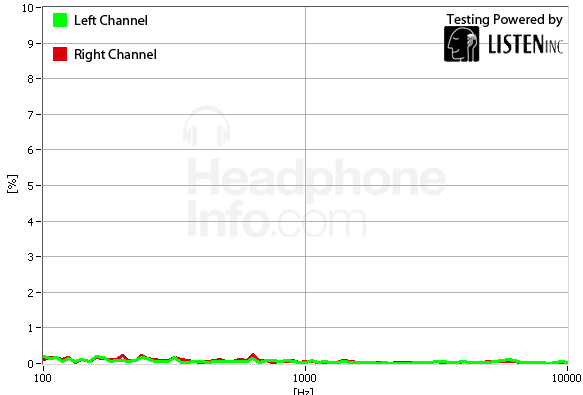
Click here for more information on our frequency response test.
Tracking
{{section_header}}{{section.name}}{{/section_header}}
The PS200s' tracking wasn't atrociously off. They seem to be slightly louder in the right channel than in the left. This could be fixed with positioning, potentially; the difference is a not-terribly-noticeable 4dB louder in one channel. This is at its worst in the low end, and then gradually increases back to a nominal level, at which point it scribbles out. Take this scribble with a grain of salt: it isn't 100% accurate since our testing equipment can't measure these decibel levels with 100% accuracy. The reason we didn't just chop it off the graph is because you can judge the trend using them. It looks like, in the high end, the decibel level goes towards the left channel even more, overall.
The differences between the channels is never significantly more than 4dB, which isn't so bad it'd annoy you. If you were to look at this graph to the right, you should know that the headphones are not perfect, but, unless you're particularly finnicky, they're good enough.
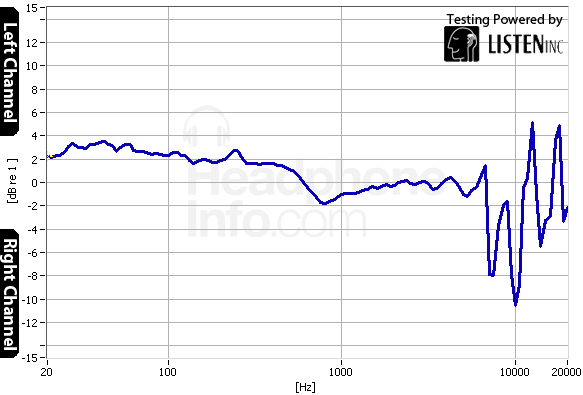
Click here for more information on our frequency response test.
Isolation
{{section_header}}{{section.name}}{{/section_header}}
The PS200s had an average isolation score. Like most in-ears, they didn't isolate well in the low end, but did a significantly better job towards the high end. Typically in-ears can block out slightly more sound overall, but the PS200s are definitely better than the average set of portable over-ears or on-ears in this regard.

Click here for more information on our isolation test.
Leakage
{{section_header}}{{section.name}}{{/section_header}}
The PS200s did a good job on our leakage test. If you're listening to your music at a reasonable level, you won't bother someone sitting next to you in a quiet room. If you amp up the volume, however, those around you might hear a tinny whisper. This is true of all headphones, however; they can't blockade infinite volume.
Click here for more information on our leakage test.
Maximum Usable Volume
{{section_header}}{{section.name}}{{/section_header}}
The Phiaton PS200s were capable of about 121dB output. Our max score for this section is awarded for 120dB, which is a bit louder than any sane, safe person would typically want. Feel free to boost the volume on your PS200s without any distortion flaring up.
Click here for more on our maximum usable volume test
Short-Term Use
{{section_header}}{{section.name}}{{/section_header}}
The Phiaton PS200s are comfortable enough, but they didn't stay in our ears well at all. We pushed them in as far as they'd safely fit, but we never got the sense that they were locked in place. Even a gentle tug or pull would make them fall out of place. When we wore them sitting down we didn't run into the issue, so the PS200s are probably better suited for use in the office rather than the gym.

Extended Use
{{section_header}}{{section.name}}{{/section_header}}
Typically when in-ears have an issue with popping out, over the course of six hours there isn't much difference. Chances are, if we think we're less comfortable than after an hour it's because we've had to deal with the headphones popping out six times as much as our one-hour session, simply due to the longer length of time. In this case, however, we also noticed some slight discomfort from pressure. We wore the normal-sized sleeves, then switched to the smaller ones for a second trial: there wasn't a significant difference in comfort level (and yes, we invested 12 hours of our time into this entirely subjective score, just so we could be sure before handing our knowledge over to you, our valued reader).
Of course, the heads used to test these headphones at the office are likely not yours and even more likely an entirely different shape altogether. Even without personal preference thrown in there's enough justification for you to try on the headphones and make your own opinions before buying; after you calculate each permutation of personal preference, there's significantly more justification to do so, so please, do try on all headphones for at least a few hours before you decide to buy/keep.
Customizability
{{section_header}}{{section.name}}{{/section_header}}
The Phiaton PS200s don't have a lot in the way of customization. It has a neck split and three different sized sleeves to choose from, all of the same basic design. This is a standard offering from an entry-level set of in-ears, but typically headphones in the PS200s price range come with a few extras, such as extension cords, or different sleeve shapes.
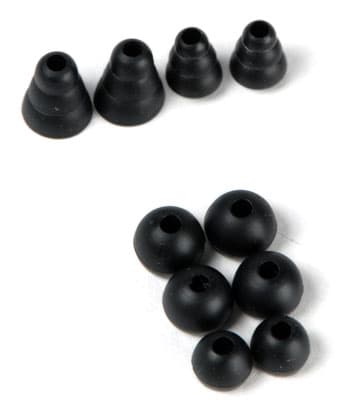

Cable Connectivity
{{section_header}}{{section.name}}{{/section_header}}
The Phiaton PS200s' cable is just over 4 feet, 2 inches. This is an average length for a set of in-ears, meaning it'll reach down to the front pocket in your pants with a bit of slack, but it won't go much further. These are not good headphones for hooking up to a device on the opposite side of the room. If you're far away from the sound source you want to connect to, most in-ears aren't going to be able to meet your needs.
Portability
{{section_header}}{{section.name}}{{/section_header}}
As in-ears, the Phiaton PS200s are very, very portable. If you wanted, you could easily ball them up and shove them in a pocket. They also come with a snazzy case that manages the cord and has little pegs to mount the sleeves on, which will keep them from falling all over the ground every time you take out your headphones. The problem with the case is that it isn't portable itself. The case is pretty big; not something you could feasibly fit in your pocket, or at least do so without a giant cube-shaped protrusion on your thigh. The headphones themselves, however, are very portable.
Maintenance
{{section_header}}{{section.name}}{{/section_header}}
Some in-ear headphones come with a cleaning tool. Like many in-ears, the PS200s do not. You can remove the sleeves for easier cleaning, however. This is the average level of maintenance you'll see on a pair of in-ears.
Other Features
{{section_header}}{{section.name}}{{/section_header}}
Battery
Some headphones require batteries, which is totally lame. Batteries die and need to be replaced or charged, which is an additional hassle in your life that we're pretty sure you don't need. We don't care what awesome feature the battery is powering; batteries themselves are a pain. For not having anything to do with batteries whatsoever, the PS200s get some points.
Design
{{section_header}}{{section.name}}{{/section_header}}
The Apple In-ear headphones have the better design. The Phiaton PS200s suffer from the same bad plug, but they don't have the cord guard issue they simply don't look as good as the Apple In-ears. Sure, the Apple In-ears have somewhat worn out their aesthetic novelty, but they still have a better overall aesthetic.
Frequency Response
{{section_header}}{{section.name}}{{/section_header}}
The two headphones have pretty much equivalent frequency responses. They both have decent bass, weaker mid-range tones, and a screwy high-end. The PS200s result was slighty better than average, while the Apple headphones were slightly worse than average. On this one, the PS200s come out in the lead slightly.
Distortion
{{section_header}}{{section.name}}{{/section_header}}
The Apple In-ears had less overall distortion. Even with the noise towards the high end (that little plateau towards the right in their graph), they still have much less overall distortion. The only time the PS200s have a leg-up in this situation is if you like listening to quiet or a capella music, where the Apple In-ear's noise will likely be more apparent than the PS200s evenly-spread distortion.
Tracking
{{section_header}}{{section.name}}{{/section_header}}
If you couldn't guess by looking at the graphs, the Apple In-ears have a much better tracking.
Isolation
{{section_header}}{{section.name}}{{/section_header}}
The Apple In-ears actually take home the gold here, although it might not be 100% apparent from looking at the graphs. If you'll notice on the low end, the Apple In-ears have a giant bump while the PS200s maintains a low overall isolation level. Also, towards the high end the PS200s have a bit of a divot while the Apple In-ears are more well-rounded. For isolating either bass or higher-end sounds, the Apple In-ears are better headphones.
Comfort
{{section_header}}{{section.name}}{{/section_header}}
This section is a bit of a toss-up. If you plan on moving around, the Apple In-ears will fall out less. If you're sitting down, however, the PS200s will fall out less. If you wear them under your jacket/shirt/blouse/torso covering, the friction between the fabric and the cord will be enough to pull the PS200s out of place constantly. The Apple In-ears will still fall out, just not as much. When sitting, the PS200s will stay in, while the Apple In-ears will gradually fall out all on their own.
Verdict
{{section_header}}{{section.name}}{{/section_header}}
These two headphones are actually very comparable, providing you aren't necessarily looking for a remote and mic. The PS200s had slightly better frequency response, the Apple headphones had slightly less overall distortion: in the end, the PS200s have slightly better audio quality.
The main deciding factors in this match-up will be your personal preference and price. Personal preference we really can't touch upon since we have no idea who you are (aside from whatever our traffic analytics software tells us). If you're looking for a deal, the Apple headphones are a better choice. We think the Apple In-ears might be more suitable for commuters, while the PS200s are a better set of office headphones.
Design
{{section_header}}{{section.name}}{{/section_header}}
The main thing others see when you're wearing in-ear headphones are the backs of the ear buds. Which would you rather have, a fan blade or a somewhat plain set of headphones that have a splash of red? If it were up to our office to pass down an unbreakable mandate on this entirely subjective subject, we'd have to side with the splash of red. Just about everyone in the office agreed that the fan design looked a bit off. If it strikes a chord with you, however, remember this when you read our verdict.
There is the other end of design, however, which is how well-constructed the headphones are. In this regard, the CX 300-IIs
Frequency Response
{{section_header}}{{section.name}}{{/section_header}}
The Sennheiser CX 300-IIs had a better frequency response overall. The curves of the two response graphs are very similar, but the CX 300-IIs managed to do a better job overall: they don't stray as far outside the limits, emphasis doesn't shift as starkly, and the two channels remain more consistently in sync.
Distortion
{{section_header}}{{section.name}}{{/section_header}}
This is a pretty cut and dry case of 'the Sennheiser CX 300-II headphones have less distortion than the Phiaton PS200s.' This classic truism aside, the differences in distortion levels aren't likely to bother the average listener.
Tracking
{{section_header}}{{section.name}}{{/section_header}}
Both headphones have about the same level of above average tracking. The PS200s start heavy on the right and gradually stabilize, but there are a few bumps along the way which will be more noticeable shifts in volume distribution. The CX 300-IIs started out way off to the right but quickly correct themselves. This quick correction might mean a bass instrument playing across these frequencies will sound as though it wanders off to the right every once in a while.
Isolation
{{section_header}}{{section.name}}{{/section_header}}
The PS200s actually do a slightly better job isolating sound, but not by a giant amount.
Comfort
{{section_header}}{{section.name}}{{/section_header}}
The CX 300-IIs are definitely the more comfortable headphones to wear. They pop out much less and fit much better overall.
Verdict
{{section_header}}{{section.name}}{{/section_header}}
In terms of audio quality, the CX 300-IIs are better than the PS200s. In terms of comfort, the CX 300-IIs are better than the PS200s. In terms of value, the CX 300-IIs are better than the PS200s. Those looking to hedge their bets are probably a lot better off picking up the CX 300-IIs.
Design
{{section_header}}{{section.name}}{{/section_header}}
In this category, the PS200s have a better chance of winning. We say this because, although we didn't personally like the aesthetics of the PS200s, they at least look different from the run of the mill. The Shure SE420s are pretty blah.
The SE420s are much more durable than the PS200s. The PS200s have a flimsy transition from the plug to the cord while the Shure SE420s have one of the best-protected plugs on in-ears. Of course, the unfortunate downside of the SE420s is their lack of a cord guard at the ear buds. Although this junction will likely receive far less stress than the plug juncture, it's still an issue, especially if you routinely crumple up the headphones and shove them in your pocket. In this area, the PS200s have a better design, but overall the SE420s take this section of the comparison.
Frequency Response
{{section_header}}{{section.name}}{{/section_header}}
Both headphones had frequency response results that were roughly average. The PS200s had a response that went a bit outside the limits and featured emphasis changes that were a tiny bit more extreme than we would've liked. The SE420s have a much more stable frequency response, but towards the very high end of our limits they fall down sharply. The PS200s squeak out a slight advantage here.
Distortion
{{section_header}}{{section.name}}{{/section_header}}
Both headphones did pretty well here. The Shure SE420s had slightly more distortion than the PS200s. Most people won't be able to notice this difference, but those that do should be aware that there is a small difference.
Tracking
{{section_header}}{{section.name}}{{/section_header}}
While both headphones did a pretty good job on this test, the SE420s' tracking curve is noticeably more flat. Again, however, the difference in quality is very likely to be lost on most sets of human ears.
Isolation
{{section_header}}{{section.name}}{{/section_header}}
Unlike the past few sections, the SE420s soundly best the PS200s on isolation, not only overall, but on just about every individual frequency along the way (minus the few at the 1kHz mark).
Comfort
{{section_header}}{{section.name}}{{/section_header}}
The Shure SE420s are actually pretty comfortable for a set of in-ears and have a lot of customization options to choose from. Shure offers more sleeve options than the great majority of headphone companies out there (with Etymotic Research the only company that's given them a good run for their money). The PS200s fall out a lot and are, in general, less comfortable than the Shures.
Verdict
{{section_header}}{{section.name}}{{/section_header}}
One chronic problem with Shure headphones is that they're just a bit over-priced. They're great headphones, but other companies offer generally equivalent headphones for less money. In this case, the Shure headphones are actually under-priced by comparison. While the PS200s have slightly better audio quality overall, we're not sure the change in price is necessarily indicative of the increased quality.
If you're looking for a pair of commuting headphones, the SE420s are the better bet because they isolate better. If you're just looking for a pair of headphones to use around the public library (and who isn't?) then it's more of a toss-up. Both headphones have significantly different fits, so try both of them out.
Design
{{section_header}}{{section.name}}{{/section_header}}
The AH-C351s look simple but sharp and professional. The PS200s, on the other hand, look a bit less plain. In terms of durability, both headphones are about the same level of average. This one is too close for us to call: they're similar enough that it'd come down to personal preference, and whatever opinion you can muster just from looking at the two pictures below is more relevent than our own.
Frequency Response
{{section_header}}{{section.name}}{{/section_header}}
The PS200s have a better overall frequency response in this comparison, by quite a large margin. They have a valley in about the same spot as the AH-C351s, but the AH-C351s' valley is far deeper and steeper. The depth and angle of the slope indicate the severity of the shift. In the AH-C351s' case, an instrument in this area would sound a bit muted and if the instrument straddles this area, it will sound like it fades in and out.
Distortion
{{section_header}}{{section.name}}{{/section_header}}
Both headphones performed about the same on this test, with the AH-C351s narrowly edging out the PS200s. There isn't enough difference between their distortion levels to influence anyone's purchase, however.
Tracking
{{section_header}}{{section.name}}{{/section_header}}
The Denon AH-C351s have a slightly better tracking overall. There is a bit of a bump towards the 1kHz mark, but the PS200s feature two bumps of about the same magnitude and are slightly more off-kilter.
Isolation
{{section_header}}{{section.name}}{{/section_header}}
The PS200 was able to block out significantly more sound than the Denon AH-C351s.
Comfort
{{section_header}}{{section.name}}{{/section_header}}
The Denon AH-C351s were more comfortable overall and popped out far, far less.
Verdict
{{section_header}}{{section.name}}{{/section_header}}
If we took price out of the equation, the PS200s are probably the better set of headphones. The AH-C351s have better tracking and are definitely better headphones to take to the gym, but the PS200s have a better overall audio quality. If you're not going to move around much, the PS200s clinch a clear victory. Once you account for price, however, the PS200s become a horrible value in comparison. Sure, they're better headphones overall, but their price is scaled on an entirely different magnitude than the AH-C351s. If money is no object and you're looking at only these two headphones, the PS200s are the better pick.
Conclusion
{{section_header}}{{section.name}}{{/section_header}}
The Phiaton PS200s are a good set of entry-level headphones that have an unfortunately disproportionate price. On our comparisons, they often offered slightly better audio quality, but did so at a disproportionately higher price. In terms of performance, the PS200s performed a tiny bit better than the Shure SE420s and the Apple In-ear Headphones and compared favorably to the Denon AH-C351s: these three headphones are $50, $170, and $200 less expensive than the PS200s, respectively.
Even if you are crazy in love with their aesthetics and don't run into the fit issues we did, $250 is a bit much for the PS200s. If you can pick these headphones up for about $200 or cheaper, and they fit you perfectly, the PS200s arent a bad set of entry-level in-ears.
Meet the tester
Mark Brezinski works on the Home Team, reviewing refrigerators, minifridges, dishwashers, washing machines, dryers, air conditioners, air purifiers, and fans.
Checking our work.
Our team is here for one purpose: to help you buy the best stuff and love what you own. Our writers, editors, and lab technicians obsess over the products we cover to make sure you're confident and satisfied. Have a different opinion about something we recommend? Email us and we'll compare notes.
Shoot us an email
